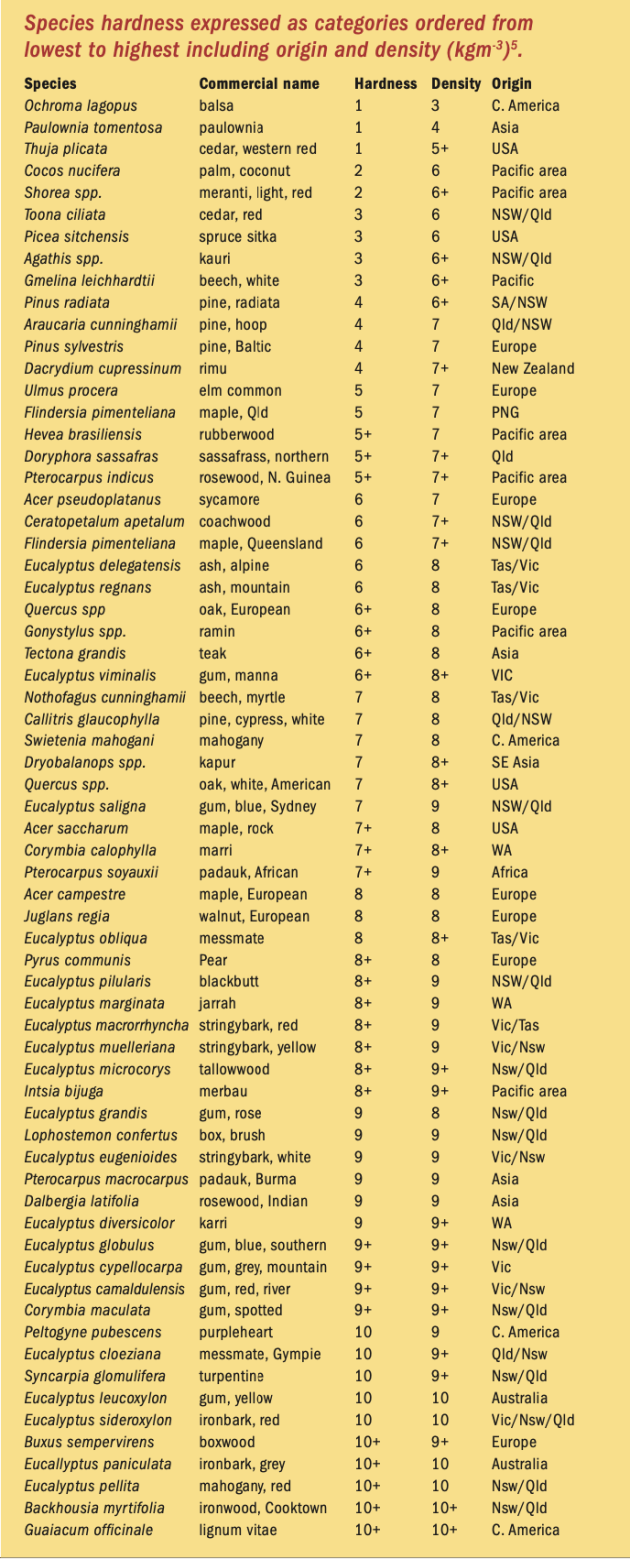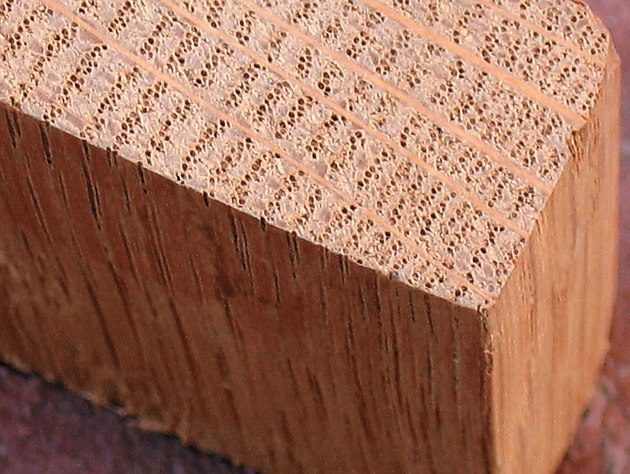What makes wood 'hard' or 'soft'
Endgrain vessels and wide rays visible in true oak (Quercus).
Words and images: Dr Jugo Ilic
It may be thought that the terms hardwood and softwood refer to woods with the corresponding attribute. Some enthusiastic salespeople may even try to sell that notion. In actual fact the terms ‘hardwoods’ and ‘softwoods’ are neither accurate nor descriptive, since some softwoods are actually harder than some of the hardwoods, e.g. white cypress pine (Callitris glaucophylla) is harder than Qld maple (Flindersia pimenteliana), elm (Ulmus sp), cedar (Toona ciliata) and mahogany (Swietenia macrophylla). The structure of the wood, however, is typical for each of these two classes and is responsible for such differences in physical properties that adapt them for different purposes.
Botanically, the commercial softwoods are conifers classified in a group called Gymnosperms, a term which broadly signifies plants bearing exposed seeds, which usually originate in cones. The other botanical group, which includes the various orders of hardwoods, is the class of Angiosperms, which have true flowers in the popular sense and seeds enclosed in a fruit.
Most northern temperate conifers have needle-like or scale-like leaves which, except in the larches, persist throughout the winter. The broad-leaved trees on the other hand, are deciduous. In Australia and in the tropics, the latter usually do not drop their leaves in autumn and many conifers do not have needles, e.g. celery op pine or brown and black pine (Podocarpus).

Straight grain of pine superimposed on its endgrain
The woods of hardwoods are characterised by pores which are large open cells running along the length of the stem known as vessels through which sap moves in the living tree. In many cases pores in wood are visible to the naked eye as tiny grooves on the sidegrain or as small openings on cleanly cut endgrain. The size and distribution is responsible for the texture of the wood.
The arrangement of the pores form characteristic patterns which can affect the grain and figure and are also useful for differentiating the species, the most characteristic pattern is in ring-porous species such as oak and elm which exhibit two distinctly different sizes of pores. The other type of arrangement is diffuse porous as in the eucalypts and wattles and most tropical species. In this case the pores are more or less evenly distributed when viewed on the cross section.

Table data source: Kloot, N.H. & Bolza, E. (1961) Properties Properties of timbers imported into Australia. CSIRO Division of Forest Products Tech. Paper No 12
Woods have three other types of cells (fibres, parenchyma and rays) of which the fibres are the most numerous and can be found in both hardwoods and softwoods. Rays are cells running from the bark to the pith. In certain hardwoods such as silky oak (Grevillea) or she-oak (Casuarina) these wood rays are conspicuous and easily seen by the naked eye. When such woods are quarter cut, the rays result in what look like flakes which give the veneer or wood an outstanding figure.

Highly figured 'wavy' endgrain
Parenchyma, sometimes called soft tissue, are similar cells to the rays but they run along the length of the stem and like the vessels, form characteristic patterns when present, e.g. concentric bands in fig-wood (Ficus) and rose mahogany (Dysoxylum fraserianum), surround the vessels in merbau (Intsia) or ramin, and are almost absent in ash eucalypts. The fibres form the bulk of the wood in most species and their characteristic cell wall thickness affects the hardness and the density of the wood. The thicker the fibre cell wall, the stronger and harder the wood will be.

Ray stripe in tangential sidegrain silky oak
Measuring hardness
Hardness as applied to timber usually means its resistance to indentation or penetration and, according to the standard procedure, is determined by measuring the load required to embed a ball 0.444-inch diameter to half its depth, thus creating a cavity with the surface area of one square centimetre. This test is known as the Janka hardness test. It enables the hardness of timbers to be recorded and compared.

Above: A Janka hardness test setup. A little hollow is visible on the wood sample after the testing. Photo courtesy Dr Ross Farrell, Centre for Sustainable Architecture with Wood, Univ. Tas.
Consequently, the average hardness of King William pine (one of the softest Australian timbers) is 460lb at 12% moisture content, whereas that of grey ironbark is 3,100lb using the old imperial units. (lb=pound and N=Newton; both are units of force. 1kN = 1000N. To convert imperial units to metric units; 1lb=4.44822N (1000 lb = 4448.22N or 4.44822 kN.)
Putting it another way King William pine would need a weight of 460lb to push the half the ball into the wood. (Note: Older publications usually give the Janka rating as lb (pounds) force.)

Significant pressure would have been needed to cause the indentation on this ironbark floor.
On the other hand a 3,100lb weight is needed to do the same thing for grey ironbark. This property, resistance to indentation, is also usually a measure of the difficulty in working the timber either by hand or with machine tools. However, some timbers, such as Queensland walnut and brush box, tend to be more difficult to work than would be expected from their measured hardness. This is probably due to the presence of deposits of tiny silica grains in the cells of such timbers.
End and sidegrain
Although, in general, the resistance to indentation is a measure of the timber’s ability to resist wear when subjected to abrasion (as in flooring), there are exceptions. For example, the end hardness of timber is usually about 25% higher than the side hardness, but the resistance to wear of the endgrain is usually much greater than would be indicated by this difference.
Measured values differ in each of the three structural directions of the wood (tangential, radial and transverse). When the measured hardness is compared to the density of the wood, it is found that an increase in one property leads to an increase in the other. This also applies to the crushing strength.

Balsa has the softest rating on the scale and is easily marked.
As with all mechanical properties, with the possible exception of toughness (impact strength), hardness increases as wood dries out. Sidegrain (tangential and radial) hardness is lower than that for endgrain, but it also increases from green to dry wood by approximately 30% in hardwoods and 40% in softwoods. In practice it is often found that sidegrain hardness in the two directions is similar and published sidegrain values quoted in the literature are usually given as an average of the individual radial and tangential directions.
To get a better appreciation of the importance and the similarity between hardness and density of hardwoods and softwoods a list of species is shown below. Hardness rating often referred to as Janka ratings are usually expressed in kN and density (expressed as kgm-3) is provided for woods commonly used by woodworkers and as flooring timbers.
The species are arranged in order of increasing hardness with the lowest value first. The values for hardness and density have been coded into 10 categories and each category represents a range of measured values as described. Representation of properties using categories has two major advantages. Firstly, it makes the overall comparisons between the timbers relatively simple – it can be seen quickly which timbers are similar and which ones are markedly different. Secondly, it avoids quoting the actual timber property values which tends to imply an unrealistic exactness.

Dr Jugo Ilic worked as a wood scientist at CSIRO for 36 years. As part of his research activities he authored the CSIRO Atlas of Hardwoods and curated the Australian Wood Collection. He has written several articles for Australian Wood Review, some of which are shown above right. This article was first published in issue 59, 2007.



